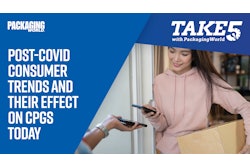Significant emphasis has been put on sustainability due to the rise of single-use packs, e-commerce, and personal protection equipment due to COVID-19, so the push for sustainable packaging is strong. Stories about marine life choking on plastic packaging are popular in the news and cringeworthy to the packaging industry. Therefore, more time, thought, and talent need to go into developing sustainable packaging, based on consumer-driven wants and needs.
Since it is important to rethink packaging, where can organizations begin this process? One of the first steps is to define the most important aspects of sustainability during the planning and design process. This is important because sustainable packaging can be complex and convoluted. What does sustainability mean to consumers vs. manufacturers of packaging? Are they the same?
The focus on sustainable packaging is holistic and incorporated throughout the entire supply chain. No matter where your organization is on the sustainable packaging journey, here are five thoughts to help drive packaging designs that meet your organization’s sustainable goals:
1. Develop realistic and robust criteria.
• What aspects of sustainability are most important to you?
• Develop questions to ask your suppliers and end-users.
• Continuously seek ways to make packaging more sustainable.
2. Create a strategy and set sustainability goals based on what is most important to you and your organization.
Develop a mission statement, rank, set metrics, and track progress. It takes research to determine what is most important and attainable, but it is well worth the effort. Make sure you have a packaging subject matter expert to focus on sustainability involved in this process from start to finish and to include stakeholders across the supply chain.
Some elements to consider as metrics are developed:
• Carbon footprint—the simplest description comes from the dictionary. “The amount of carbon dioxide released into the atmosphere as a result of the activities of a particular individual, organization or community.” Use a robust and standard calculation that incorporates carbon dioxide produced through the entire lifecycle for analysis of each package. The impact of fossil fuel usage will be captured here. However, there may specific elements you will track as metrics of your sustainability goals.
• Energy use—Quantify energy requirements to manufacture the packaging and include raw materials.
• Materials—Understand the difference between renewable vs. non-renewable materials. Examples are sand, water, wood, air, and petroleum.
• Circularity—What is most important to you? Can you successfully incorporate increased recycled content, ensure your packaging will be recycled in a well-defined manner, or use packaging that is recyclable? Will your organization be part of this process or will recycling be dependent solely on customer participation and availability of recycling facilities near the end user?
• Composting—What elements remain once the packaging is composted? Do your target customers compost or have access to the space and materials to compost the materials?
• Transportation—How much, what distance, and what types of transportation are required from cradle to grave? A heavier, voluminous pack will increase the carbon footprint.
• 3Rs & 1U—Understand the differences between reduce, reuse, recycle, and upcycle. Prioritize these options based on set organizational goals. Understand what packaging is most commonly recycled and which packages are recyclable but difficult to collect, clean and process.
• Waste—Understand waste and how much packaging will realistically end up in a landfill. This includes discarded waste, including recyclable or compostable packs that escape the intended stream and end up in a landfill. Most landfilled products will not break down, no matter what the material is.
• Cost differential—Cost most likely will increase to implement the chosen packaging. Will the company, consumer, or a combination of both, be willing to absorb the cost?
3. Beware of using jargon and conflicting information as you make decisions and set sustainability goals.
Greenwashing is the practice of touting cost savings or material choice as a sustainable initiative when it is basically a cost savings. This includes changes such as coatings, laminates, inks, minimized use, and recyclable material without a mature recycling plan.
4. Most importantly, determine where your company stands on the sustainability spectrum and where you want to be in the long run.
Develop a Lifecycle Assessment to capture valuable information as the packaging is reviewed.
5. Implement your packaging.
Find the best partners to design, test, and deploy your packaging so you can clearly declare how and why it meets your sustainability mission.
These suggestions should help companies that are constantly saying their packaging is sustainable to further define what sustainability really means to them.
Camille Chism is Principal at Indigo Packaging & Consulting and an IoPP Certified Packaging Professional Lifetime and Fellow. For more information on IoPP, please visit www.iopp.org.


























